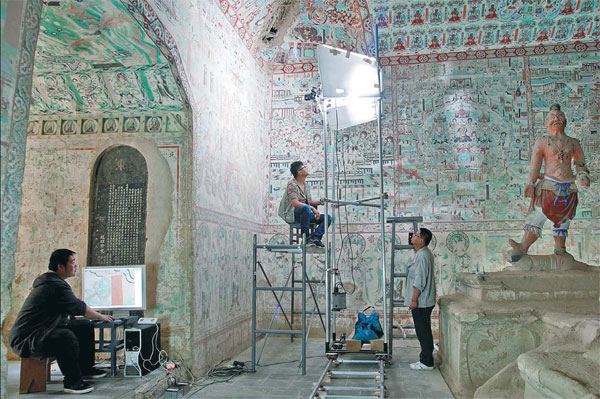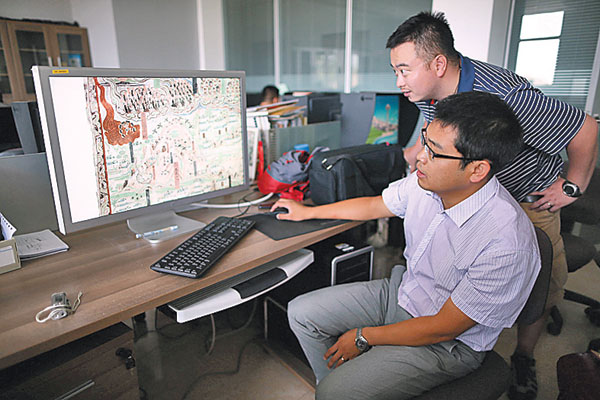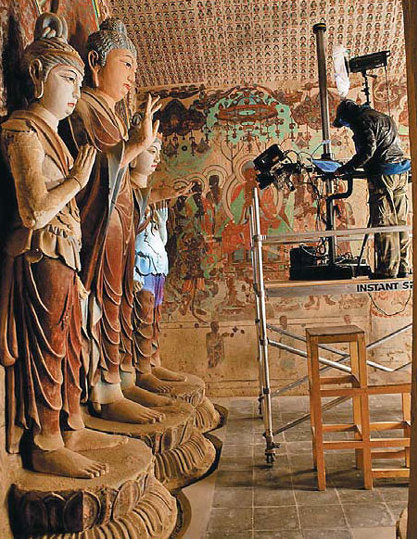Holding onto history
Updated: 2013-08-14 07:40
By Liu Wei (China Daily)
|
||||||||
|
A photography team captures images of ancient murals in a cave of Dunhuang Mogao Grottoes, in Gansu province. Provided to China Daily |
|
Workers from Dunhuang Academy's digital center examine murals on computer. Chen Xi / For China Daily |
Ancient murals in Dunhuang Mogao Grottoes are in danger of disintegrating. Preservationists are desperately trying to digitize the important relics before they are gone forever. Liu Wei reports.
'The murals are aging, like me," says Fan Jinshi, 75, president of Dunhuang Academy.
For 50 years Fan has been conserving and studying the murals and other splendid relics in Mogao Grottoes, one of the greatest cultural wonders of the world.
The paintings on the surfaces of caves dug into mountains in Dunhuang, a small town in Northwest China's Gansu province, are extremely fragile heritage.
The caves were built between the 4th and 14th centuries, through more than 10 successive Chinese dynasties. One generation of painters after another filled them with murals illustrating Buddhism and daily life.
These precious artworks, however, are now at risk from arid weather, natural deterioration and the impact of tourism.
Among the 735 caves in Dunhuang, 492 contain murals and colored statues. Sadly, half of the murals are at risk of being lost.
Fan and her colleagues believe the future preservation of the murals lies in digitization.
"The foremost purpose of digitization is to build a digital archive," says Sun Zhijun, deputy director of Dunhuang Academy's Digital Center. "So people can still appreciate the murals' beauty and study their value hundreds of years later."
The ambitious project started in 1999, when the Andrew W. Mellon Foundation funded a joint project between Dunhuang Academy and Northwestern University of the United States. Archivists digitized 22 caves in five years, using rails like train tracks to stabilize cameras moving over the uneven cave surfaces - hardware the American experts brought from Hollywood to capture the murals.
At first the team used traditional cameras, sent the film to the US and scanned the photos into a computer. Digital cameras were adopted in 2000, but the photos' resolution could only reach 75 DPI (dots per inch, or per 2.54 cm, a measure of printing resolution).
Thanks to the continuous upgrading of digital cameras, now the photos are of 300 DPI, good enough for archiving and printing.
In the field
A photography team usually includes a photographer, three assistants and a quality supervisor who ensures the right focus and size.
They divide the murals into small pieces, each 31 by 47 cm and take photos of them. According to Sun, one square meter of mural needs about 60-70 photos.
Once the photos have been taken, there is a long, drawn-out process to piece them together using a computer. Sun says 688-square-meter Cave 61 took two and a half months to photograph and about seven months to piece together on the computer.

The cooperation with Northwestern University ended in 2003. Yet the academy has not stopped improving the technology and digitization process. The tracks used to only be available in one size, now the digital center develops tracks of three different widths to suit different caves. The cameras used to only work with regular light, but now only cold light can be allowed to protect the murals.
The conservation work was greatly enhanced in 2011 when Microsoft Research Asia donated a video camera with a resolution of 1.3 billion pixels, to the academy. The two institutions started to develop the camera in 2010.
The academy divides the caves into four categories according to cultural importance. Sun's team expects to digitize all the 147 A-list caves by 2015.
The digitization is a time-consuming project, but it is urgent, too. The contradiction bothers Sun and his team members.
"We would love to digitize the murals as soon as possible, especially when we see the effects of the destructive earthquake in 2008 in the neighboring Sichuan province," Sun says. "But to accelerate the project means having more people in the cave at the same time, which harms the fragile murals, too."
Tourist delight
Now Mogao Grottoes receives about 6,000 visitors every day. In peak seasons such as the National Day holiday in October, daily attendance can reach 12,000 people.
Although president Fan designed eight different routes to divert tourists and all visitors must be taken through the caves with a guide, each tourist spends about 90 minutes in the caves.
According to the Academy's observation, when 40 people stay in a cave for 30 minutes, the temperature rises by four degrees and the content of carbon dioxide increases by five times.
"The murals, even those we think have been well protected, already look very different compared to photos taken in 1908," Sun says.
Fan will try to convince the tourists to spend more time in a visitors' center when it opens in May 2014.
The center contains an interactive, documentary screening room and high-fidelity duplications of the caves with a tourist reception hall, a multimedia display area, a digital theater, a dome theater, restaurants, shopping area and other facilities.
Tourists will learn about the grottoes' beauty and their value in the center, which decreases the time they spend inside the caves.
The merits of the digitization will enhance the interactive experiences for tourists by leading them on a virtual tour of the caves and allow them a closer look at the intricate details of the murals that may not be easily appreciated inside the dark caves.
Fan expects the center will reduce the time tourists stay in the real caves to one hour.
"We never claim the virtual tour can replace the experience of the real caves," says Fan. "To conserve the site we all need to put in some effort. It can be an endless process. But, just like an old person having operations, we will not complain that it's way too many."
Contact the writer at liuw@chinadaily.com.cn.
|
A photographer zooms in on a statue in a cave of Mogao Grottoes. Provided to China Daily |
(China Daily USA 08/14/2013 page8)

 Huawei unveil Ascend P6 smartphone in Vienna
Huawei unveil Ascend P6 smartphone in Vienna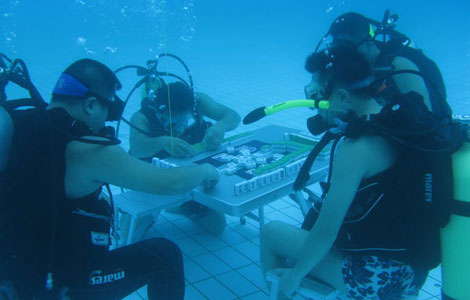
 That's one cool game of mahjong
That's one cool game of mahjong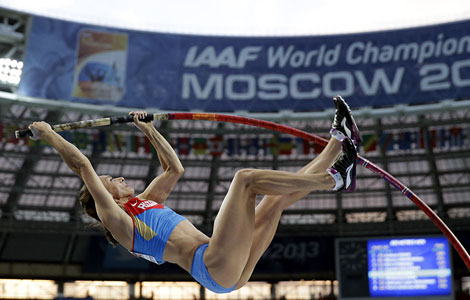
 Isinbaeva leads harvest day for host Russia
Isinbaeva leads harvest day for host Russia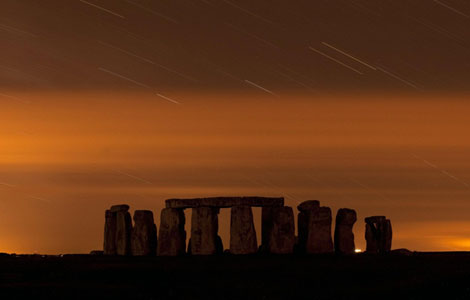
 Perseid meteor shower puts on show in night sky
Perseid meteor shower puts on show in night sky
 Bird flu, slowdown hit sales at fast-food chains
Bird flu, slowdown hit sales at fast-food chains
 PetroChina poised to dominate Iraqi oil
PetroChina poised to dominate Iraqi oil
 Marriage attitudes slowly change
Marriage attitudes slowly change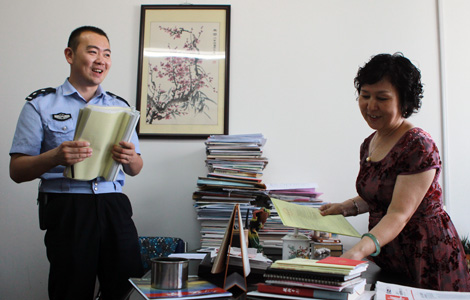
 On frontline of fight against crime
On frontline of fight against crime
Most Viewed
Editor's Picks

|

|
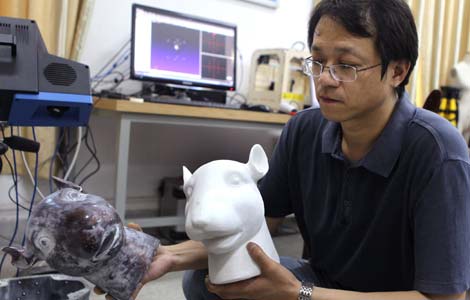
|

|
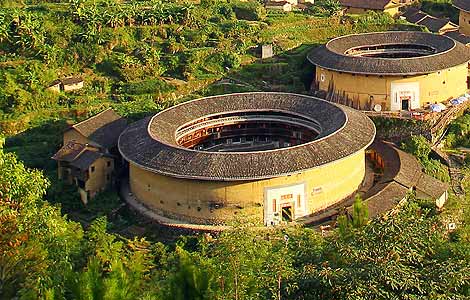
|

|
Today's Top News
Brazil demands clarifications on NSA surveillance
2nd-generation ID cards to include fingerprints
Chinese students boost boarding business in US
TCM chain probed after illegal house exposed
Friends of accused Boston bomber due in court
Economic hub on Bohai Bay
PM to visit China for milk scare
Donors of organs easing transplant shortages
US Weekly

|

|
